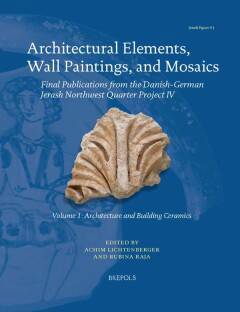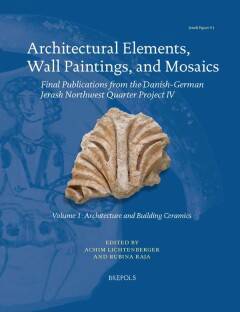
- Afhalen na 1 uur in een winkel met voorraad
- Gratis thuislevering in België vanaf € 30
- Ruim aanbod met 7 miljoen producten
- Afhalen na 1 uur in een winkel met voorraad
- Gratis thuislevering in België vanaf € 30
- Ruim aanbod met 7 miljoen producten
Zoeken
Architectural Elements, Wall Paintings, and Mosaics
Final Publications from the Danish-German Jerash Northwest Quarter Project IV
Achim Lichtenberger
Paperback | Engels
€ 159,00
+ 318 punten
Omschrijving
The Decapolis city of Jerash has long attracted attention from travellers and scholars, due both to the longevity of the site and the remarkable finds uncovered during successive phases of excavation that have taken place from 1902 onwards. Between 2011 and 2016, a Danish-German team, led by the universities of Aarhus and Munster, focused their attention on the Northwest Quarter of Jerash - the highest point within the walled city - and this is the fourth in a series of books presenting the team's final results. This two-part set offers a comprehensive presentation of Jerash's rich building heritage from the Late Hellenistic period up to the city's destruction in the mid-eighth century ad through a discussion of architectural elements, together with analysis of the mosaics, wall paintings, and building ceramics excavated from the Northwest Quarter. As well as providing a general overview of the city's changing patterns of habitation, the contributions gathered here also include close case- studies and object biographies that shed new light on the intense use, reuse, and recycling of materials that testify to evolving urban practices and optimization of resources across the Roman, Byzantine, and Islamic periods.
Specificaties
Betrokkenen
- Auteur(s):
- Uitgeverij:
Inhoud
- Taal:
- Engels
Eigenschappen
- Productcode (EAN):
- 9782503596662
- Verschijningsdatum:
- 26/05/2022
- Uitvoering:
- Paperback
- Formaat:
- Trade paperback (VS)
- Gewicht:
- 8296 g

Alleen bij Standaard Boekhandel
+ 318 punten op je klantenkaart van Standaard Boekhandel
Beoordelingen
We publiceren alleen reviews die voldoen aan de voorwaarden voor reviews. Bekijk onze voorwaarden voor reviews.








